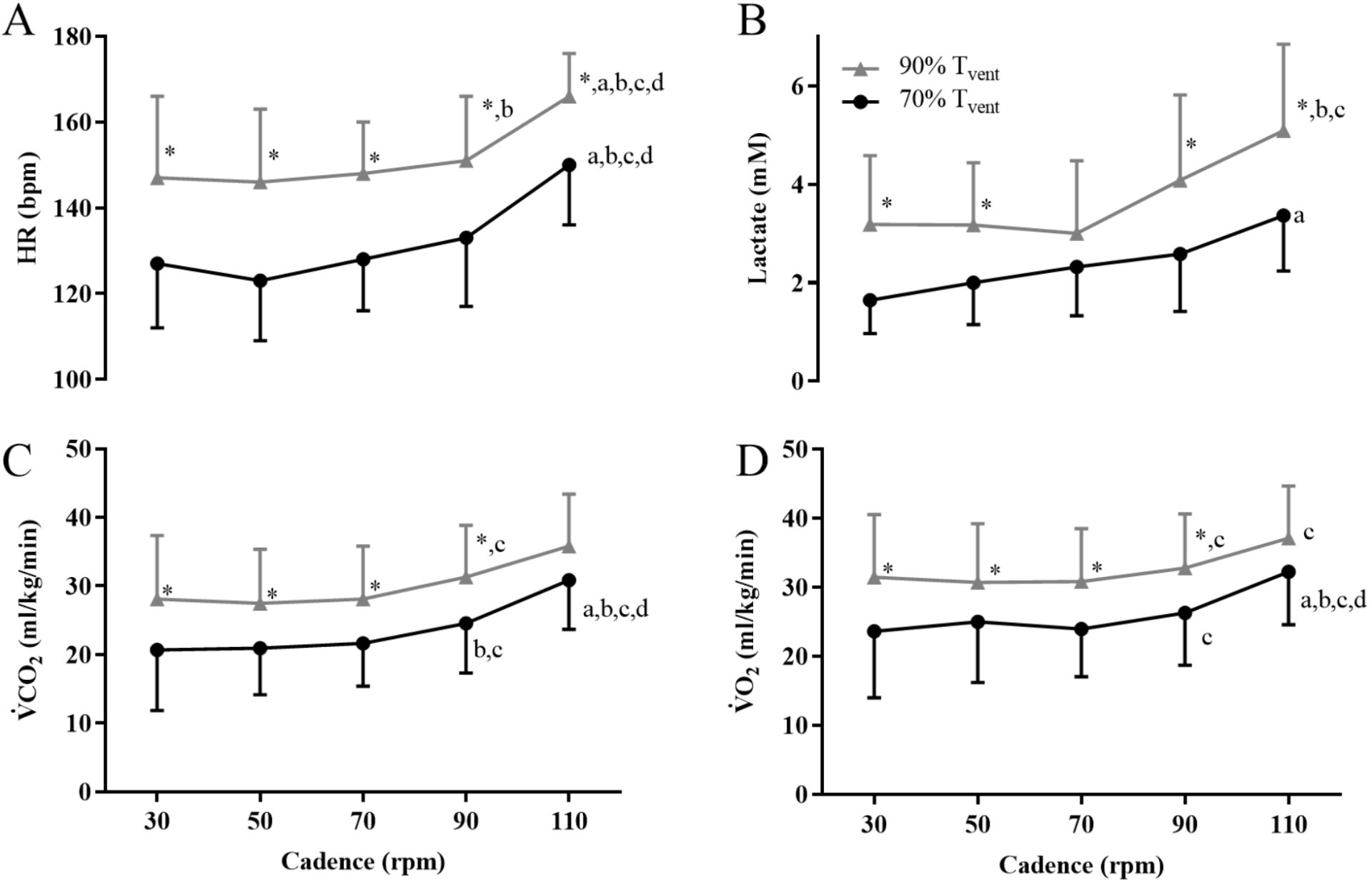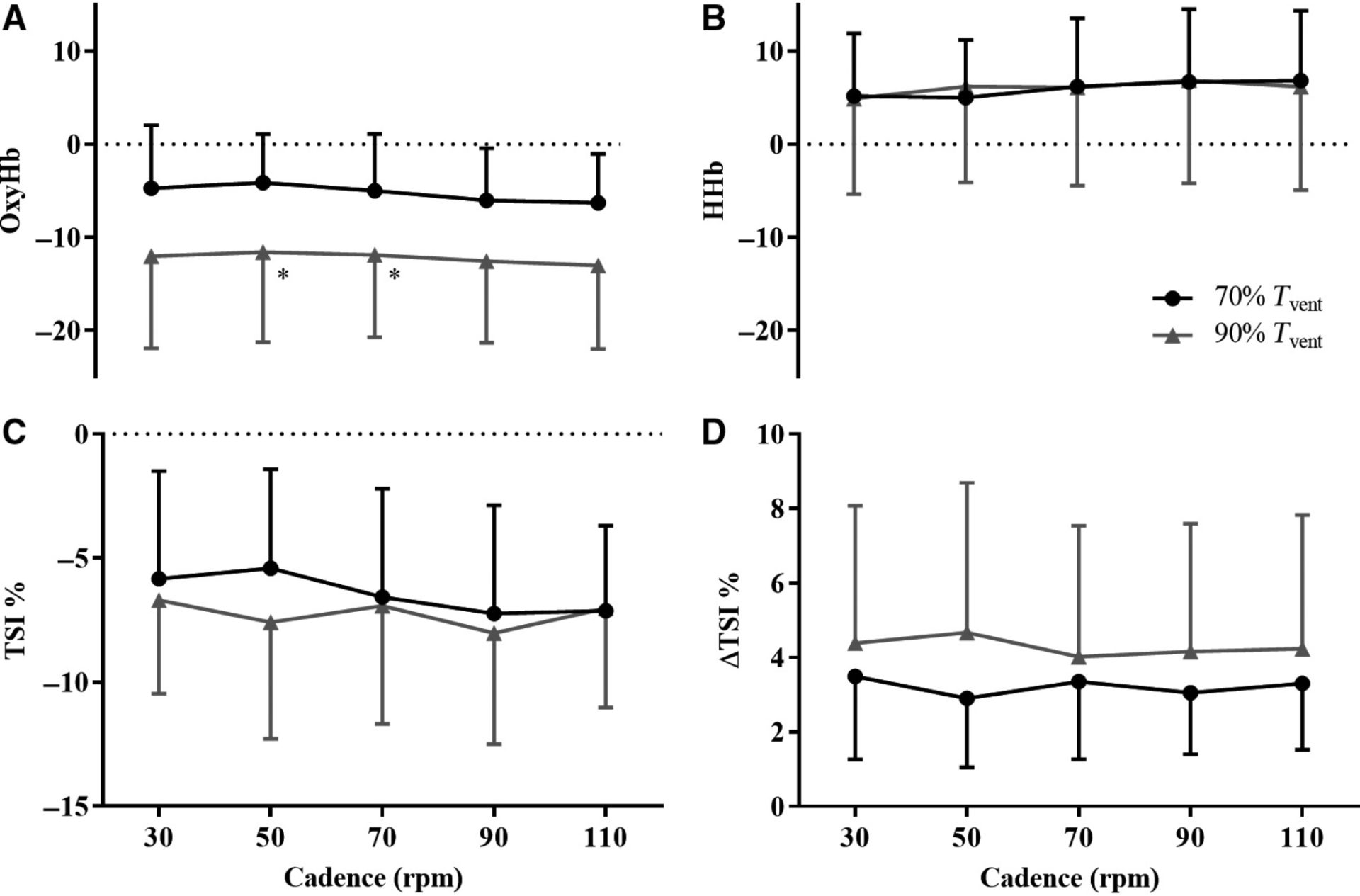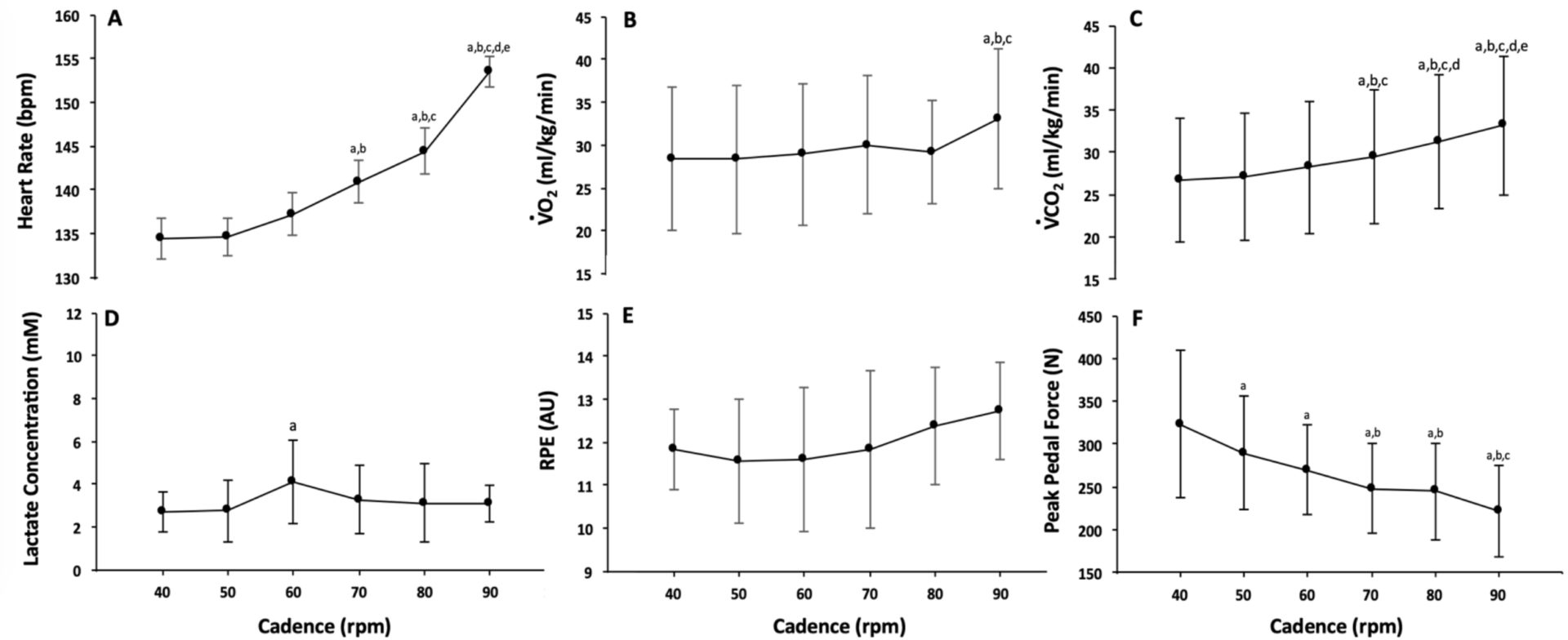The selection of pedalling cadence during cycling may be determined by a number of factors, including the degree of oxygenation in the exercising skeletal muscle. It is generally accepted that muscle oxygenation decreases while cycling at increasing work rates, when metabolic rate increases (1). In contrast, muscle oxygenation response to increased cadence at a fixed work rate is less clear (2, 3). The purpose of the two studies presented here was to determine muscle oxygenation at different cycling cadences and work rates. Sub-Tvent study: Cardiopulmonary and metabolic responses to cycling were recorded in 12 participants at work rates of 70% and 90% of the ventilatory threshold (Tvent). Participants cycled at cadences of 30, 50, 70, 90, and 110 revolutions per minute (rpm), in a randomised sequence with 110 rpm performed last. Each cadence was sustained for 4 min, interspersed with active recovery periods (4). Skeletal muscle (vastus lateralis) oxygenation was measured using near-infrared spectroscopy and tissue saturation index (TSI) determined. Tvent study: A similar protocol was used to measure TSI in 9 participants at cadences of 40, 50, 60, 70, 80 and 90 rpm. Work rate was equal to 100% Tvent (5), with cadences tested as above for 4 min each, in a randomised sequence with 90 rpm undertaken last. Data were analysed with two-way repeated measures ANOVA corrected for multiple comparisons with Bonferroni’s post-hoc test. Cardiopulmonary and metabolic responses were greater at 90% than at 70% Tvent, and at 110 rpm compared with lower cadences (Figure 1), but vastus lateralis oxygenation changes from baseline were not different between the two work rates or between the five cadences tested (Figure 2). At a work rate equal to 100% Tvent, the cardiopulmonary and metabolic responses were again greater at the higher pedalling cadences (Figure 3). At this higher work rate, the TSI reduction from baseline was significantly greater at 90 rpm (−14±4%) than at 40 rpm (−12±3%) and 50 rpm (−12±3%) (P=0.027 and 0.017, respectively) (Figure 4). Our results demonstrate that elevated pedalling cadence at a work rate equal to 100% Tvent can significantly reduce vastus lateralis TSI and confirm previous findings (1) for skeletal muscle oxygenation being unaffected by pedalling cadence at workloads below Tvent. These findings suggest that skeletal muscle oxygenation is affected by high cadence when cycling at a work rate equal to Tvent and may only be a determinant of self-selected cadence during cycling at this exercise intensity.
Physiology 2019 (Aberdeen, UK) (2019) Proc Physiol Soc 43, PC106
Poster Communications: The effects of work rate and pedalling cadence on skeletal muscle oxygenation during cycling
C. Dockerill1,2, L. Shastri2, M. Alkhalil2, C. Forbes2, G. Rafferty2, T. Takaishi4, L. Zhang3, K. Ishida3,5, F. Formenti2,6,7
1. Cardiovascular Clinical Research Facility, The University of Oxford, Oxford, United Kingdom. 2. Centre for Human and Applied Physiological Sciences, King's College London, London, United Kingdom. 3. Graduate School of Medicine, Nagoya University, Nagoya, Japan. 4. Graduate School of Natural Sciences, Nagoya City University, Nagoya, Japan. 5. Research Centre of Health, Physical Fitness and Sport, Nagoya University, Nagoya, Japan. 6. Nuffield Division of Anaesthetics, The University of Oxford, Oxford, United Kingdom. 7. Department of Biomechanics, University of Nebraska at Omaha, Omaha, USA Minor Outlying Islands.
View other abstracts by:
Figure 1. Physiological responses to cycling exercise at different work rates and pedalling cadences.Mean and standard deviation values: (A) HR (bpm), (B) Lactate (mM), (C) VCO2 (ml/kg/min) and (D) VO2 (ml/kg/min) for each cadence (30, 50, 70, 90, and 110 rpm) during 70% Tvent (black symbols) and 90% Tvent (grey symbols) tests. *P < 0.05 when compared to the same cadence at 70% Tvent. a, b, c, d: P < 0.05 when compared to 30, 50, 70, and 90 rpm respectively, at the same Tvent.HR, heart rate; bpm, beats per minute; rpm: revolutions per minute; Tvent, Ventilatory threshold; VCO2, carbon dioxide output; VO2: oxygen uptake.
Figure 2. Indices of skeletal muscle oxygenation at different work rates and pedalling cadences.Mean and standard deviation values: (A) OxyHb, (B) HHb, (C) TSI, (D) ΔTSI for each cadence (30, 50, 70, 90, and 110 rpm) during the 70% Tvent (black symbols) and 90% Tvent (grey symbols) tests. TSI changes from baseline and ΔTSI are presented as percentage values. *P < 0.05 when compared to the same cadence at 70% Tvent.TSI, Tissue Saturation Index; ΔTSI, amplitude of TSI cyclical oscillation within pedal revolution; Hb, Haemoglobin; OxyHb, Oxygenated Hb; HHb, Deoxygenated Hb; Tvent, Ventilatory threshold; rpm, revolutions per min.
Figure 3. Physiological responses to cycling exercise at different pedalling cadences at 100% Tvent.Mean and standard deviation values: (A) Heart Rate (bpm), (B) VO2 (ml/kg/min), (C) VCO2 (ml/kg/min), (D) Lactate concentration (mM), (E) RPE and (F) Peak pedal force (N) for each cadence (40, 50, 60, 70, 80 and 90 rpm) performed at 100% Tvent. a, b, c, d, e: P < 0.05 when compared to 40, 50, 60, 70 and 80 rpm respectively.RPE, Rate of perceived exertion; N, Newtons. Other abbreviations as in Fig. 1.
Where applicable, experiments conform with Society ethical requirements.



